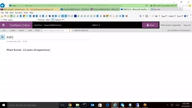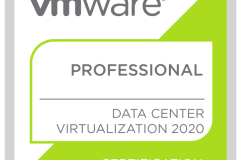VMware Training in Bangalore is a leading Training as well as Placement company with experience in leading IT Sectors of India. Our training reproduces the latest technologies, techniques, as well as processes that are advanced in practical knowledge collected from years of experience. VMware Training in Bangalore offers planned training paths intended for the certification skills necessary to work in latest technological environment, while offering a wide-ranging curriculum of application centric courses for customers looking to implement upgraded/new business applications. The purpose of software Professional training is to help students to advance their knowledge overtime while being acknowledged for their achievement.
VMware Training in Bangalore is an outstanding Online and corporate training center. We provide a number of tailored training programs for small, medium along with big organizations in Bangalore and across India. Our training courses are very cost effective for all clients/students plus students. Our training Syllabus is prepared from the team of experts and the students can improve from basic knowledge to advance level. Our Syllabus includes Installing VMware vSphere Graphical User Interfaces , Configuring VMware ESXi , Working with Virtual Machines , Configuring the vCenter Server Appliance , Standard Virtual Switches , Accessing iSCSI Storage , Accessing IP Storage , Managing VMware vSphere VMFS , Using Templates and Clones , Modifying a Virtual Machine , Migrating Virtual Machines , Managing Virtual Machines , Managing vApps , Access Control , User Permissions , Resource Pools , Monitoring Virtual Machine Performance , Using Alarms , Using vSphere High Availability , Configuring VMware vSphere Fault Tolerance , vSphere Distributed Resource Scheduler , VMware vSphere Update Manager , Installing VMware vCenter Server with practical exercises and live examples with real time experience.
Training in Bangalore is one of the greatest Software training institutes in Bangalore with 100% placement support. It has well defined training modules in addition to training sessions for pupils. At VMware Training in Bangalore, training is conducted in day time classes on all weekdays as well as weekends to suit the timings for all students and working professionals. VMware Training in Bangalore helps you acquire a foothold in the growing IT & ITeS industry. 100% Placement Assistance- While a student finishes his/ her course effectively, our dedicated Placement Cell arranges interviews with major companies. This wide hands-on experience in Software training ensures that you captivate the knowledge as well as skills that you can apply at work after your placement. All of our mentors are work specialists with years of experience in well recognized IT sectors. Learning from the work experts is the only method to understand what happens in the actual IT world.
Session: 1 – INTRODUCTION
- What its Virtualization?
- Why we are moving to Virtualization?
- VMware products and its usages
- What is Data center and detail explanation of Data center components.
Session: 2 – INSTALLATION OF VMWARE ESXI
- Overview of ESXi hypervisor.
- System requirements.
- Installation and configuration of ESXi
- Accessing ESXi via vSphere client/Web client
- What is vCenter and communication between vCenter and Esxi
Session: 3 – VIRTUAL MACHINES
- Virtual machine basics
- Creation of a VM in ESXi
- Installing an operating system in VM
- About VMware tools
- Working with VM’s
- VM files systems
Session: 4 – VCENTER SERVER
- Overview of vCenter server
- Deployment modes of vCenter server
- vCenter server for windows
- vCenter server Appliance as a Virtual Machine
- Installation of vCenter server
- Logging an accessing vCenter server
- Creation of a Datacenter and cluster.
- Adding hosts into cluster
- Accessing ESXi via vCenter server and managing its inventories
Session: 5 – VIRTUAL SWITCHES
- Overview of virtual switches
- Types of virtual switches
- Types of port groups available in virtual switches
- Reviewing the properties of virtual switches
- What is vLAN?
Session: 6 – STANDARD SWITCHES
- View the current standard virtual switch configuration
- Create a standard virtual switch with a virtual machine port group
- Create a standard virtual switch with a VM kernel port group
- Attach your virtual machine to a virtual switch port group
Session: 7 – DATASTORES
- What are datastores.
- Different types of datastore.
- Introduction of each data stores.
- Adding data stores and extending data stores
Session: 8 – ISCSI STORAGE SYSTEM
- iSCSI datastores
- Targets & initiators of a iSCSI storage system
- creation of a iSCSI datastore
- Reviewing your storage system
Session: 9 – NFS STORAGE SYSTEM
- NFS datastores
- architecture of NFS datastore
- Creation of NFS datastore
- Reviewing your storage system
Session: 10 – MANAGING VMFS DATASTORE
- Review your shared storage configuration
- Change the name of a VMFS datastore
- Create a VMFS datastore
- Expand a VMFS datastore to consume unused space
- Remove a VMFS datastore
- Extend a VMFS datastore.
Session: 11 – TEMPLATES AND CLONES
- Creation of a Template from a VM
- Deploying a VM from a Template.
- Updating a Template.
- Cloning a VM that is powered OFF
- Cloning a VM that is powered ON
Session: 12 – MIGRATION OF VM
- Checking the requirements of vMotion.
- Types of vMotion.
- Migration of VM from one ESXi to another.
- Migration of VM files from one DS to another.
- Cross-host vMotion and cross-cluster vMotion
Session: 13 – MANAGING A VIRTUAL MACHINE
- Unregister a virtual machine in the vCenter Server inventory
- Register a virtual machine in the vCenter Server inventory
- Unregister and delete virtual machines from disk
- Take snapshots of a virtual machine
- Revert to a snapshot
- Delete an individual snapshot
- Use the Delete All function in Snapshot Manager
Session: 14 – VAPPS
- Create a vApp
- Power on a vApp
- Check the summary of a vApp
- Remove a vApp
Session: 15 – ACCESS CONTROL
- Try to log in directly to the ESXi host
- Grant no administrator access to a user
- Explore the ESX Admins AD group
Session: 16 – USER PERMISSIONS
- Create a custom role in vCenter Server
- Assign permissions on vCenter Server inventory objects
- Verify permission usability
Session: 17 – RESOURCE MANAGEMENT
- Memory management of ESXi
- Resource monitoring and management.
- Creation of Resource pools
- Verify resource pool functionality.
- Deletion of Resource pools
Session: 18 – MONITORING VIRTUAL MACHINE PERFORMANCE
- Create CPU activity
- Use vCenter Server to monitor CPU utilization
- Undo changes made to your virtual machine
Session: 19 – ALARAMS
- Condition based alarm.
- Event based alarm.
- Trigger an alarm.
- Delete/disable an alarm
Session: 20 -HIGH AVAILABILITY AND FAULT TOLERANCE
- Creation of cluster.
- Enable High Availability
- Test the working of High Availability
- HA policies and admission control
- Prepare a VM for FT
- Activate/Test & Disable FT for a VM.
Session: 21 – DRS
- Enable DRS in a cluster.
- Create load imbalance in a cluster.
- Test the functionality of DRS
- DRS rules and policies.
Session: 22 – UPDATE MANAGER
- Install Update Manager
- Install the Update Manager plug-in into the vSphere Client
- Modify cluster settings
- Configure Update Manager
- Create a patch baseline
- Attach a baseline and scan for updates
- Stage patches onto ESXi hosts
- Remediate the ESXi hosts
Session: 23– Storage Distributed Resource Scheduler
- What is SDRS
- How to create the SDRS
- Pre-requirement for SDRS.
- Session: 24– Distributed Switch
- View the current standard virtual switch configuration
- Create a new vSphere Distributed switch and created distributed port groups
- Adding up-links to distributed switch
- Migrating hosts from standard switch to distributed switch
- Session: 25– vCenter back up and patching
- Create vCenter back up by suing VAMI inter face and restore vCenter.
- vCenter pathing and up-gradation.
- Session: 26– Software defined storage
- Create VMware vSAN 3 node cluster
- VMware vSAN objects and components detail explanation
- How to enable/configure vSAN cluster
- How to create vSAN storage polices and how to assign storage polices to virtual machines
- Session: 27– cloud computing Basics
- Types cloud computing
- Cloud computing models (private cloud, public cloud and hybrid cloud)
- Cloud computing services (IAAS, PAAS and SAAS)










